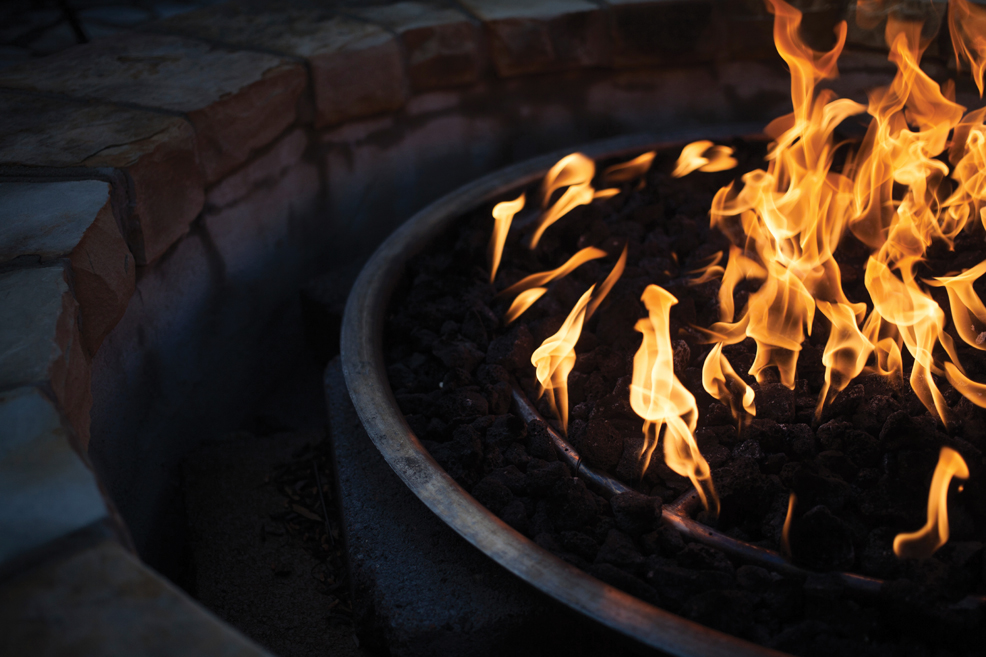
Imagine a crisp, cool evening spent gathered around a roaring fire. Kids giggle as they toast marshmallows to construct the perfect s’mores. Grownups sit back, unwind and swap stories. With all the fun and fellowship of a campfire—without ever leaving the comfort of your own backyard—it’s no wonder firepits have become the must-have outdoor item for homeowners at Smith Mountain Lake.
Firepits are attractive, functional and provide a cozy spot to spend time with family and friends — relaxing, entertaining and socializing. And thanks to Virginia’s temperate climate, they’re often used year-round at Smith Mountain Lake.
Available in a variety of shapes, sizes and styles, there’s a firepit to fit every budget. So whether you choose a low-cost tabletop model, an upscale, hardscaped masterpiece or something in between, the memories you make around your firepit are sure to be worth the investment.
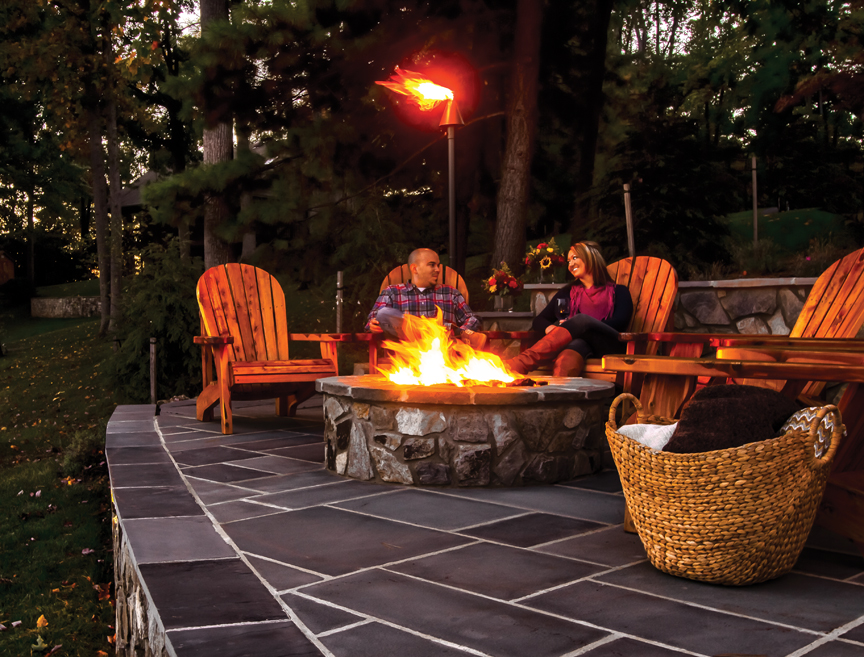 High-End Hardscape
High-End Hardscape
Many Smith Mountain Lake homeowners choose to incorporate firepits into their landscaping plans during construction or as a post-building upgrade. In 2014, Chris Mabry added a hardscaped patio area to his part-time residence in Saunders Point on Craddock Creek that includes a firepit and torches fueled by propane.
Chris says the goal was to create an area near the water for friends to gather year-round and where he could spend quality time with family, including his three daughters.
“I really wanted a spot that was inviting and had some ambiance for entertaining groups of people,” says Chris, who owns Mabry Automotive Group in Lynchburg. “We use it pretty much all year. It’s definitely a conversation area.”
Mark Maslow, owner of Southern Landscape Group, the Lynchburg-based company that designed and installed the project, says taking advantage of the property’s exceptional view of Smith Mountain was a major consideration.
“No one has their back to the lake [when seated at the firepit],” says Maslow. “It has a retaining wall behind it that allows for even more seating capacity.”
All natural stone materials were used in the construction, including flagstone with a thermal treatment to provide a smooth surface. The steps are natural slabs of stone that are maintenance free and the retaining wall includes a stone veneer designed to match the exterior of the home.
The firepit and torches are connected to a 500-gallon underground fuel tank, which also feeds the house. Propane’s advantages include no wood to gather and stoke, no embers and no ashes to clean up. The firepit lights with the flip of a switch. Another bonus is not having to deal with smoke or smoky-smelling clothes.
“That’s something I really like and my guests appreciate it, too,” Chris says.
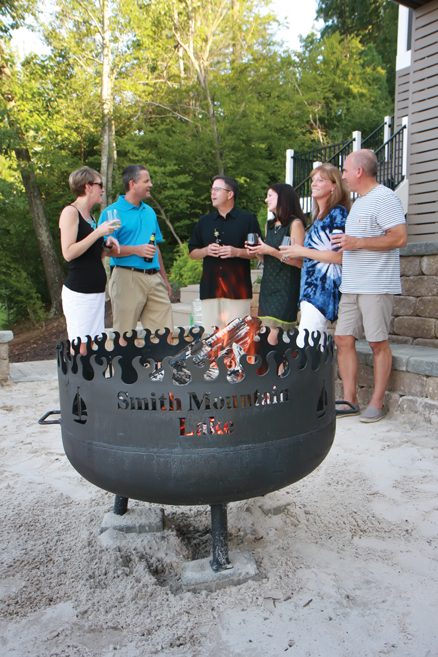 Custom Cauldron
Custom Cauldron
The firepit at the lakefront home of Matt, Nancy and Luke Erikson truly is one of a kind.
The family commissioned Duke Easley of Virginia FirePit to create a steel firepit with a lake-themed design, which they positioned on a sandy, beach-like terrace between their home and dock. The family had seen examples of Easley’s work at community events in Martinsville, where the company is based and where the Eriksons lived before moving to the south side of SML in 2009.
“When we had the opportunity to remodel and do some landscaping, we knew we wanted to have a firepit area and jumped at the chance to customize our firepit for the lake,” says Nancy Erikson, who collaborated with Easley on a design to represent the family’s new lake lifestyle: “Smith Mountain Lake” spelled out on one side and their last name and sailboats on
the other.
“I think it turned out great,” Nancy says. “I love the design, and the generous size of the bowl [36-inch model] allows us to make a small fire for just the three of us or a raging inferno when there is a larger group … We use it primarily when entertaining and sometimes just for quiet family time. Our son is now a teenager so it’s becoming a hangout spot for his friends. There are a lot of s’mores cooked over that fire.”
Easley, who started his business in 2006, works with customers individually, brainstorming ideas and creating original designs. Clients generally come to a final decision after a little tweaking and a few emails back and forth. Then Easley gets to work fabricating the firepit from 3/16-inch steel plates. He uses a CNC (computer numerical control) plasma cutter to cut out the designs, which create a striking silhouette when the firepit is lit at night. The whole process takes just a few weeks.
“Some of the cooler ones we’re doing now are the college designs,” Easley says. “I also have customers who will send sketches of what they’d like and we’re able to work something up based on those.”
Virginia FirePit’s creations come in three sizes and start at $385 for the 24-inch model, which includes a metal cover for when the firepit is not in use. For those who want to use their firepit for cooking, grill inserts that fit into a grooved edge are sold separately.
Easley says the firepits require minimal maintenance. “Take a wire brush to it once a year and repaint occasionally with Rust-Oleum high-temperature paint,” he says.
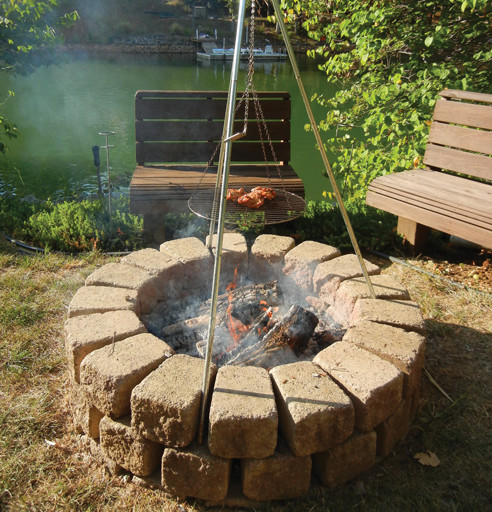 DIY with Sweat Equity
DIY with Sweat Equity
Long-time SML residents Dan and Joanne Shervey added a firepit to their lakefront landscape in 2009, opting to design and install the project themselves with help from their then-teenage son Joe, friends and neighbors.
“Everyone had a firepit where I grew up,” says Dan, who was raised on a lake in Wisconsin. “It was just a neat place to gather and have a good time. In the back of my mind I always wanted to have one here.
“What I planned to do was finish off the retaining wall in an area of our yard that basically was unusable. And when I did that, we ended up with a flat area, and I thought that would be a neat place for a firepit. I didn’t have a formal plan. I just looked at the lay of the land and designed it on the fly.”
The handy homeowners used landscaping stone and retaining wall block to incorporate additional seating around the firepit. They also built two wooden benches and a small shed to house firewood. Dan estimated the cost of materials for the project at $600, “plus a few cases of beer for my friends who came over to help.”
Additional money was spent on sod, which Joanne says contributes to the area’s cozy, comfortable atmosphere. But Dan says that’s a decision he might make differently if they were constructing the project today.
“The grass is pretty, but it’s a little more difficult to mow and weed-eat around it. Gravel or pavers might have been a better choice,” he says, also noting that some construction know-how is essential for anyone considering a DIY firepit.
“If you’re not used to doing stuff like that, it’s probably best to buy some plans and a kit. Places like Capps [Home Building Center] sell them now. And it’s important to have good friends who are willing to do some manual labor,” Dan says. “A lot of what I had to do was by hand—picking and shoveling, digging out in that red clay. And you’ve got to make sure you’re up for the pavers. They weigh 80 pounds each.”
The Sherveys say they primarily use the area in the spring and fall, but also will fire up the pit when hosting summertime dock parties. Using a tripod grill purchased at a camping supply store, they cook items such as hot dogs, brats, chicken and s’mores.
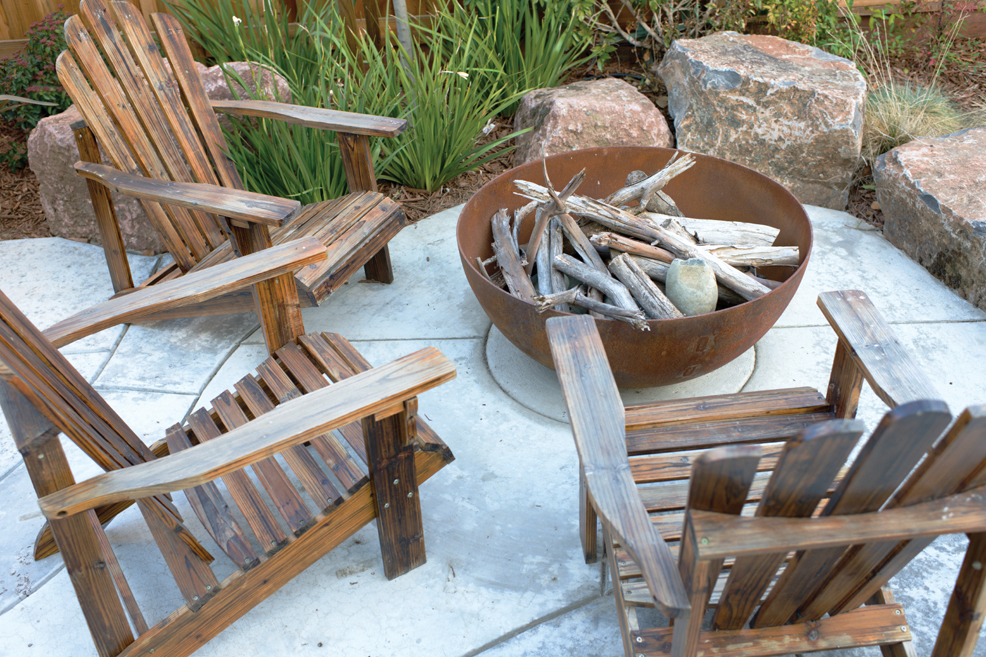 Affordable and Portable
Affordable and Portable
If you’re looking for convenience and affordability, a variety of smaller firepits are available at home improvement stores, including many that are portable. For as low as $59 you can pick up a wood-burning model that’s easy to load, rust resistant and includes a screened cover. Portable gas models also are available, starting at around $99 at big-box stores.
For those willing to spend a little more, firepit tables have also gained popularity in recent years. Often the centerpiece of a porch or patio seating area, these models offer the benefit of a table (for food and drinks) and the convenience of clean-burning propane gas. Former lake residents Tom and Julie Harkema chose a firepit table from Agio Patio Furniture when they decided to replace the outdoor furniture on their deck last year.
“We wanted something different than what everyone else has and something that would take up less space than previous furniture,” says Julie. “And we wanted it to be easy to have conversations around. We mostly use it for entertaining friends.”
The table, which was $2,300, burns propane so there’s no mess or smoke.
“I love how easy it is to turn on and it also has a great cover that is easy to put on and protect it from bad weather,” Julie says. “We do also enjoy a good fire while camping so this was one way for us to enjoy a fire at home without the mess of a real fire.”
TIPS FOR FIREPITS
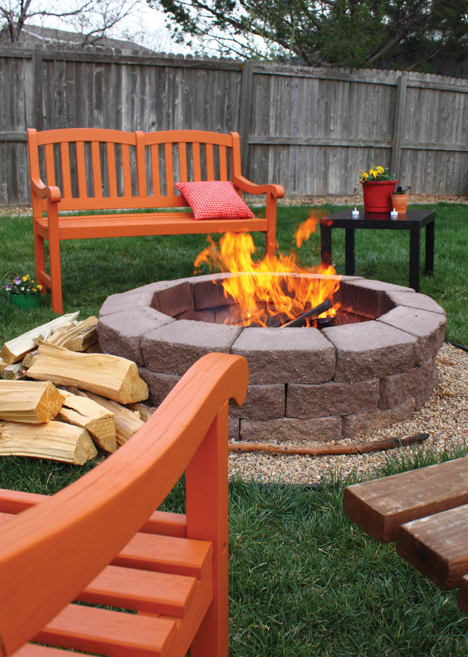 Considering a firepit? Mark Maslow of Southern Landscape Group offers these suggestions:
Considering a firepit? Mark Maslow of Southern Landscape Group offers these suggestions:
- Decide if you want wood-burning or gas-burning. If wood, think about where you will get the wood and where will you store it.
- Consider the location. If your firepit will burn wood, you want to position it so the prevailing winds don’t blow smoke toward your home or covered porches. You also don’t want to block views from other outdoor areas or from inside your home.
- Make sure the firepit is located in a convenient spot to ensure you’ll actually use it.
- Understand how big of an area you want to incorporate. If you’re not sure, consult a landscaping professional.
- Consider how big you want your firepit. Propane and wood-burning firepits require different capacities. You’ll also want to consider height. The last thing you want is a firepit that you can’t see the flame in because the firepit is too tall.
